Welcome to our Letter from Berlin!
The gallery has re-opened and we have extended Daniel Steegmann Mangrané’s exhibition Fog Dog. We look forward to welcoming you at the gallery again soon!
This week everything turns around books in our Letter from Berlin. Our bookstore, opened in 2018 with an overview of the publications of General Idea and AA Bronson, has seen a number of very special artist projects and has also become a site for readings and book launches. As its function as meeting place is on hold for now, we highlight past projects and focus on our artists’ relationship to books.
Matti Braun presents a virtual reading, in image and sound. Our Head of Content Isabelle Moffat takes his video as starting point to write about a new type of looking at books. And Gabriel Kuri speaks about his particular fondness for the conception and design of his own books and catalogues.
We present a number of outstanding recent publications and end with the round-up of this week’s social media contributions from our artists.
Anything you may have missed from our social media channels can be found on Continuity, our digital platform.
Read this in good health.
|
|
|
The Esther Schipper Bookstore
|
|
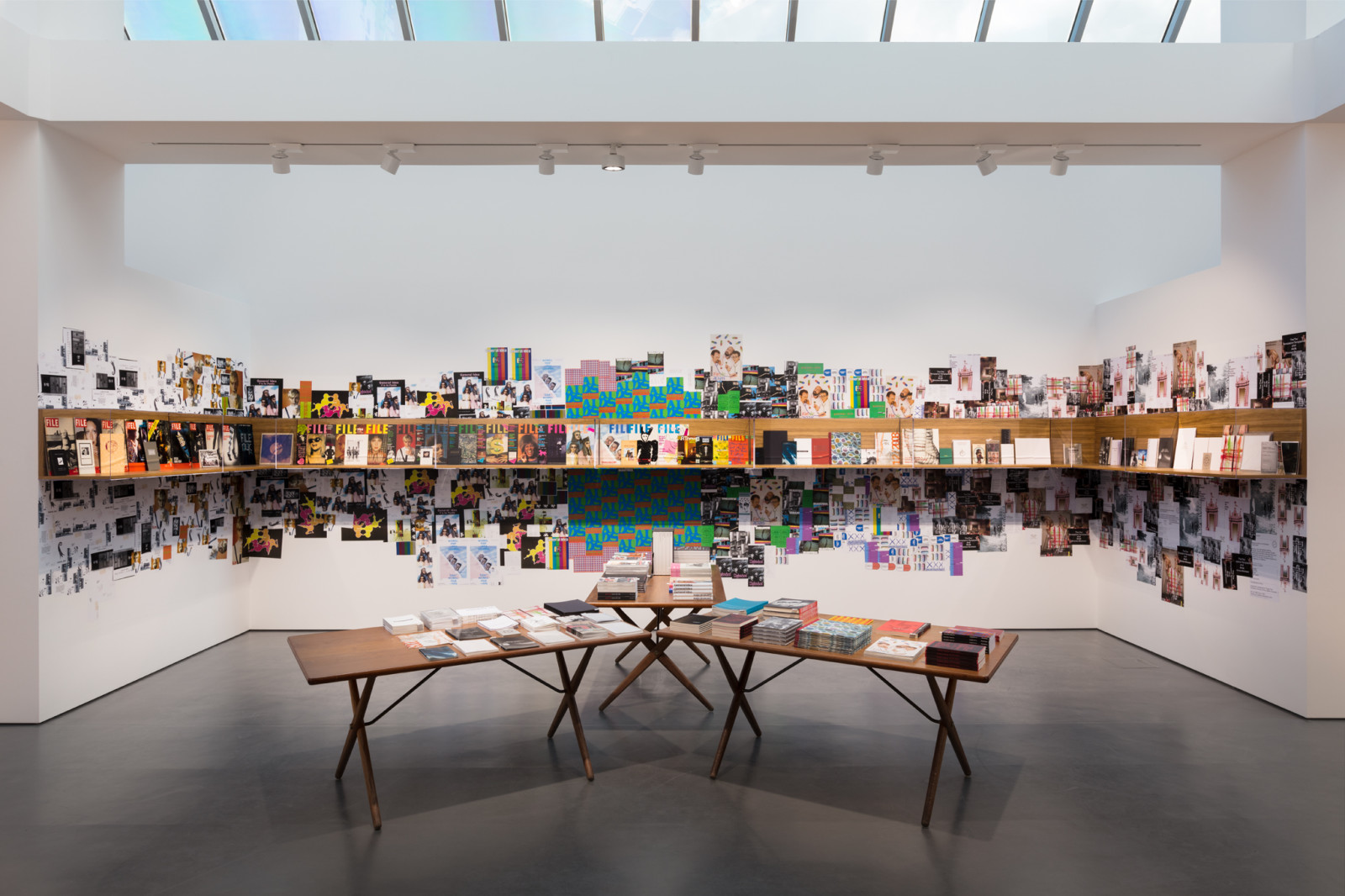
| Krishtalka Books at the Esther Schipper Bookstore. Photo © Andrea Rossetti | |
|
The bookstore premiered as pop-up space, entitled Krishtalka Books, parallel to the major overview, Catch me if you can! AA Bronson + General Idea, 1968–2018.
Organized with Sholem Krishtalka, the bookstore presentation featured catalogs, rare books, editions, zines, and ephemera by AA Bronson and General Idea. In addition to a complete set of the landmark FILE megazine and other rare publications, the walls of the space were covered with copies of ephemera found in the archive of the gallery. The placement of the tables referred to General Idea’s first exhibition with Esther Schipper, General Idea’s ¥en Boutique, which also marked the opening of her gallery in 1989.
Coinciding with Berlin’s Gallery Weekend, AA Bronson presented his edition, After General Idea, 2018, published by Three Star Books, seen below opened in the foreground.
|
|
|
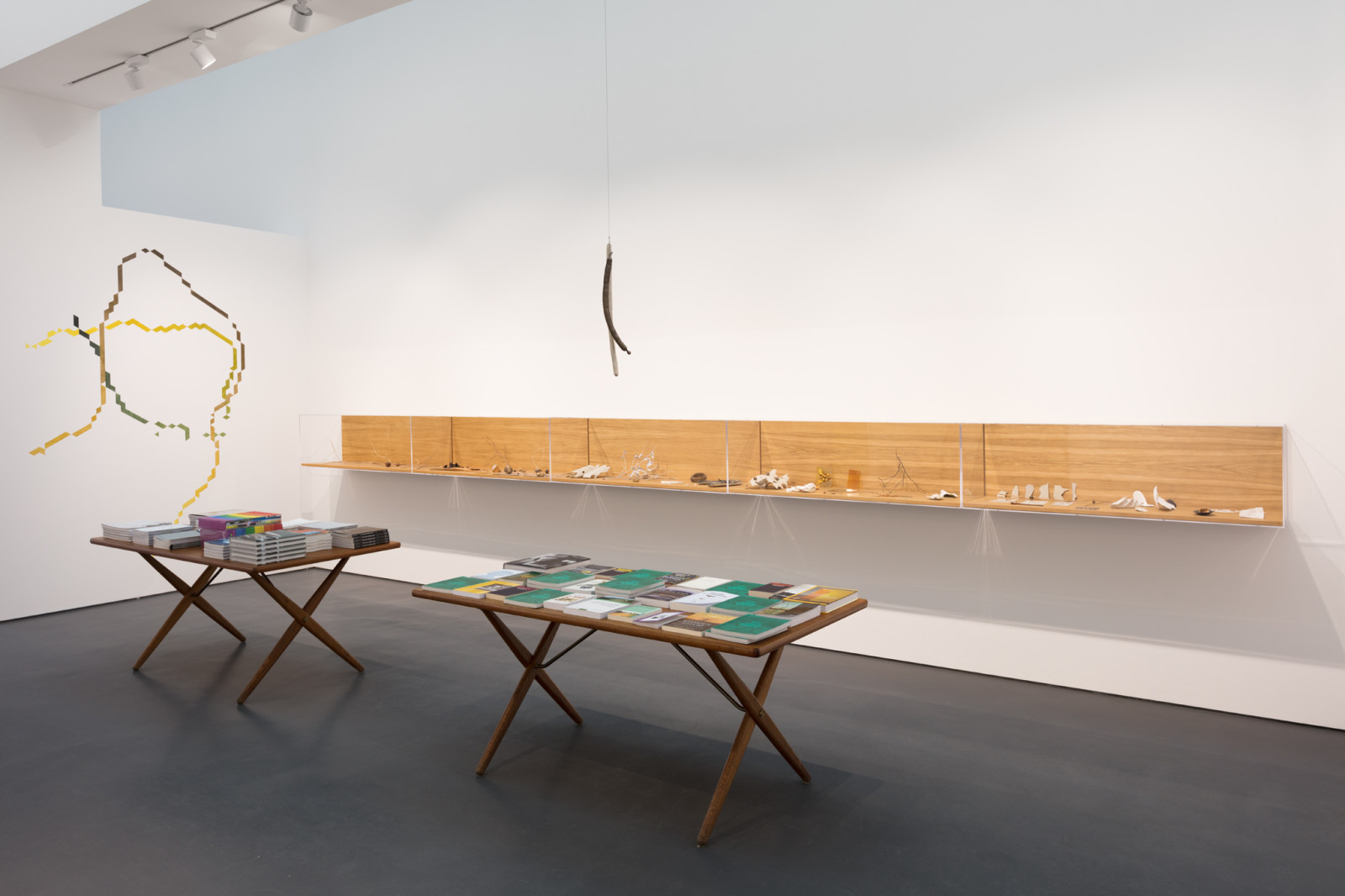 | Daniel Steegmann Mangrané. Photo © Andrea Rossetti | |
|
On occasion of his new monograph The Spiral Forest, Daniel Steegmann Mangrané adapted his work Table with Objects and presented a selection of books important to his practice with short notes on their importance. In addition, he included two large wall drawings and his edition in support of Rio de Janeiro’s non-profit art space CAPACETE (seen suspended above the table on the right).
Multiple prepared, mostly organic objects were placed inside the vitrines. Among them small split twigs, dried fruits with simple geometric patterns carded in their rind, and small wooden and glass objects. The artist has also made small constructions from organic material, imagining man-made natural elements. These assemblages are at times so believable that one wonders what tree, bush, or flower may have produced them.
|
|
|
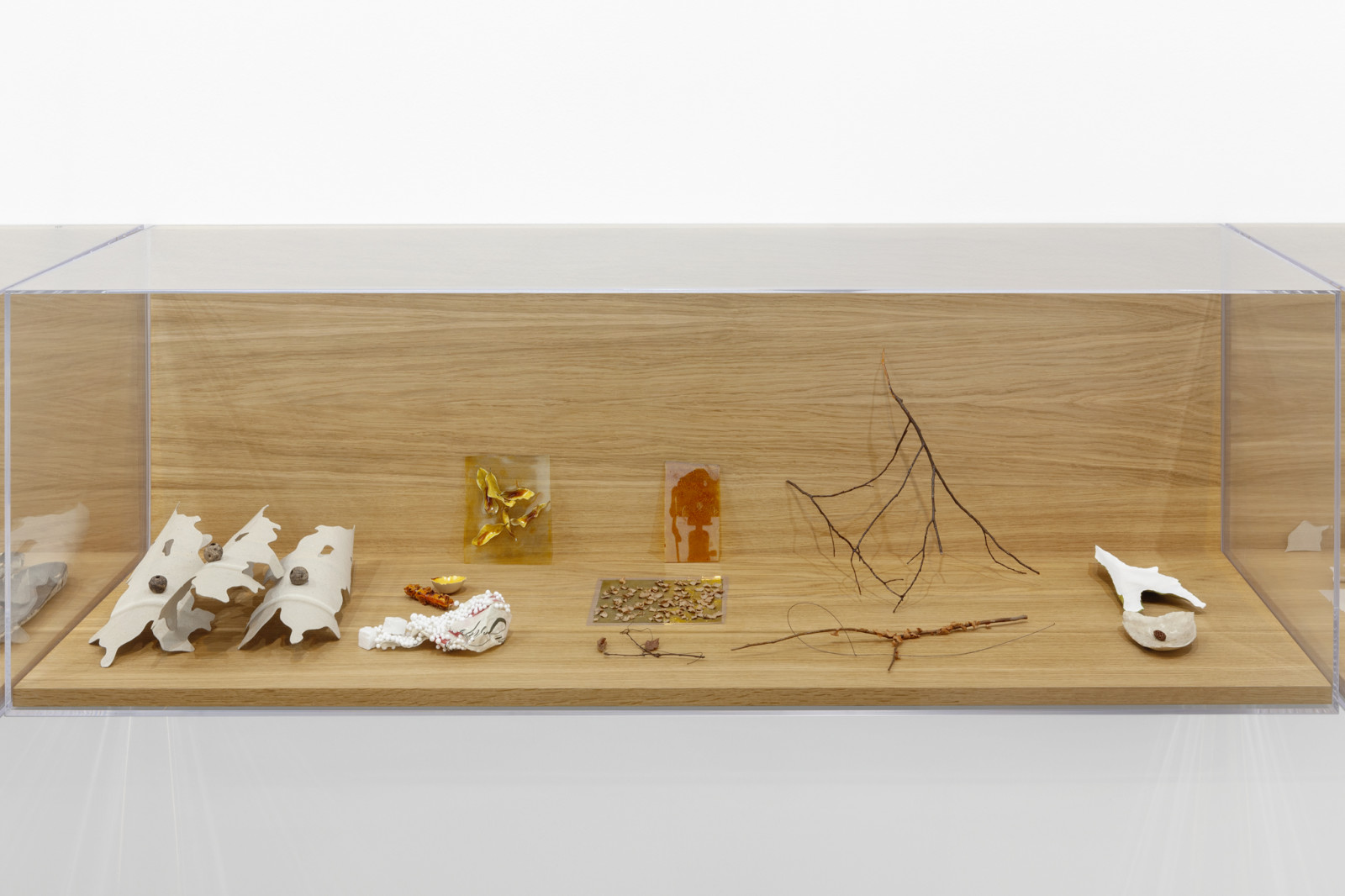 | Daniel Steegmann Mangrané. Vitrine with Objects #4, 1998-2018. Paper, dried leaves glued on plastic, packaging material, twigs, wire, found ephemera, vitrine. 42,5 x 133 x 42,5 cm. Photo © Andrea Rossetti | |
|
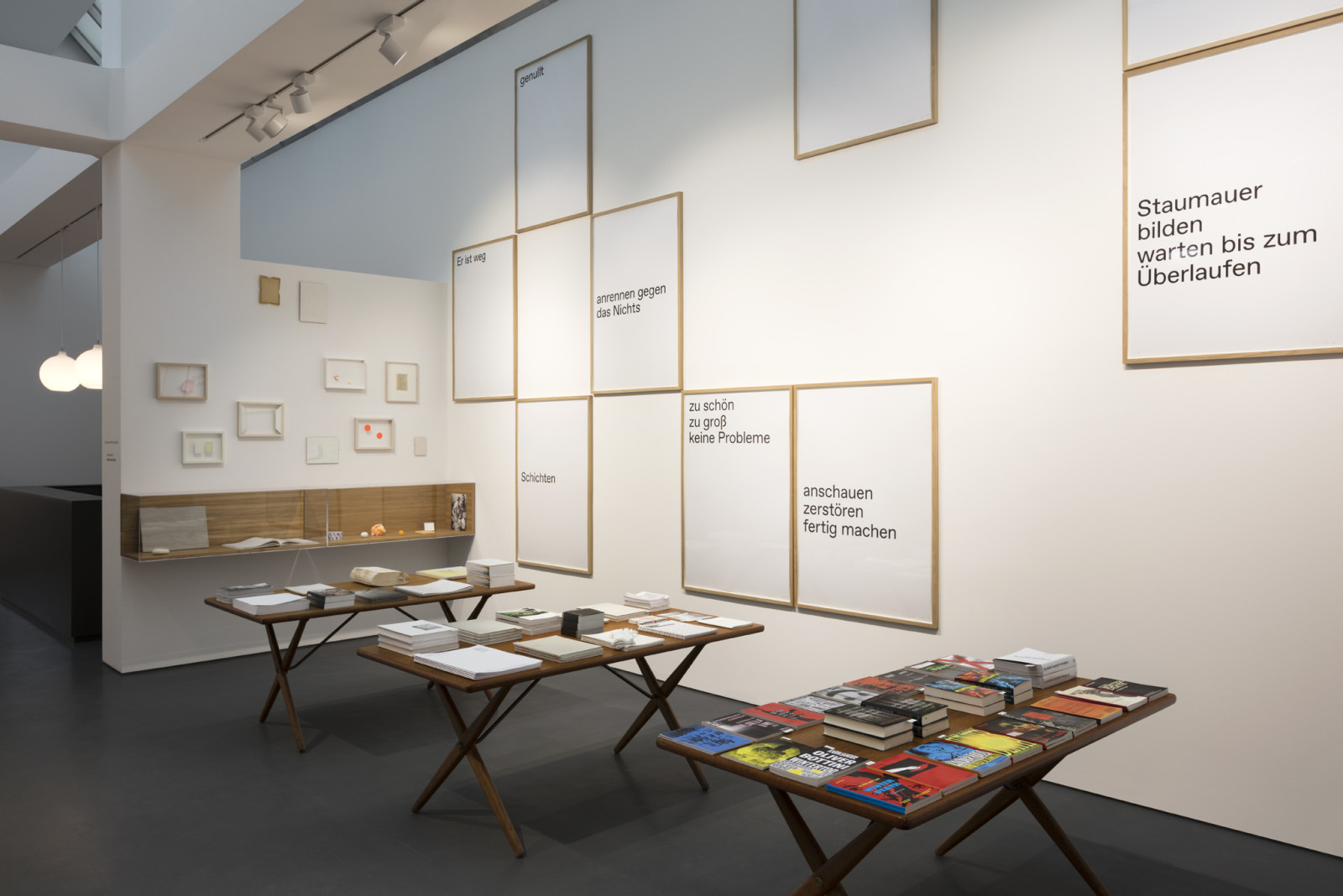 | Karin Sander. Books and Works. Photo © Andrea Rossetti | |
|
In January 2019, the bookstore presented a comprehensive presentation of books, limited editions, and rare publications by Karin Sander on the occasion of her book Karin Sander. A – Z. A book launch featured a reading by Zoë Beck from her crime story Fake It or It Didn’t Happen, published for Karin Sander’s exhibition at Kunst Museum Winterthur.
|
|
|
 | Two crime stories with a number of different covers were published on occasion of Karin Sander's exhibition at Kunst Museum Winterthur.
| |
|
 | A comprehensive selection of catalogues, editions, zines and ephemera during Gallery Weekend Berlin 2019.
| |
|
For the 2019 Gallery Weekend Berlin, the bookstore presented a comprehensive selection of catalogues, editions, zines and ephemera. We also held two book launches: one for Jean-Pascal Flavien's new book Philothée Gaymard, inhabitant of the Rietveld House, published by onestar press, 2018, accompanied by a reading by Philothée Gaymard. And one a few weeks later for Angela Bulloch's new monograph Euclid in Europe, published by Hatje Cantz.
|
|
|
 | Impression from the book launch of Angela Bulloch's Euclid in Europe, published by Hatje Cantz. | |
|
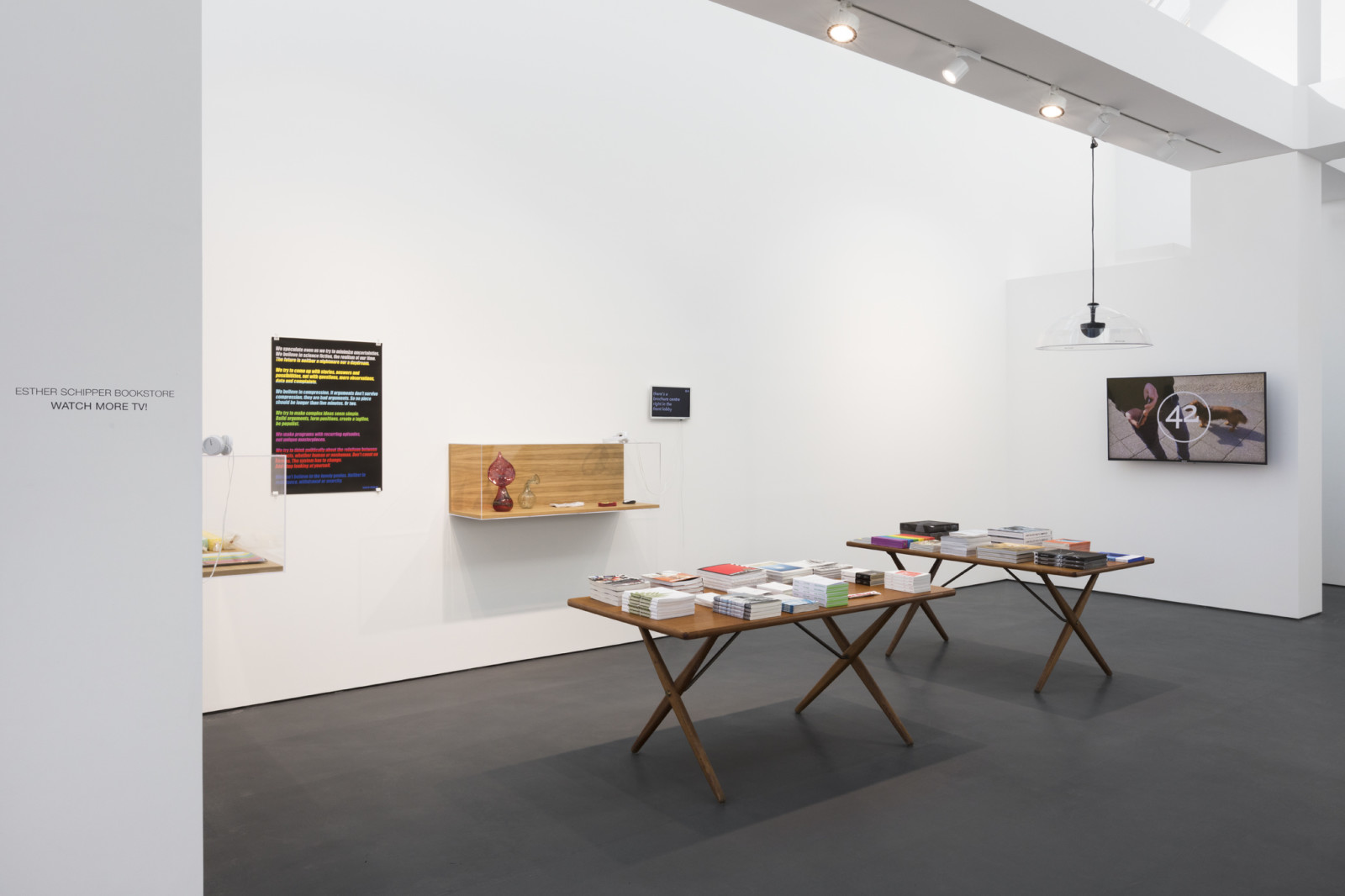 | space-time.tv, presented by Christopher Roth. Photo © Andrea Rossetti | |
|
In Summer 2019, Christopher Roth brought space-time.tv to the Esther Schipper Bookstore.
Roth whose practice may be best understood as a kind of proactive intellectual scholarship that combines the factual and fictitious, with both analytic and poetic qualities, has recently focused on the creation of a number of online television channels, summarily called space-time.tv
Roth’s work seeks to understand how information, words, pictures, and ideas are received, travel and are mediated at a constantly accelerating pace. Since the 1990s, Roth has focused on the “emptiness” of single images and certain generic imagery that surround us. These images only accrue meaning in context—a function easily manipulated by the mass media. This knowledge — acquired and practiced as an accomplished film editor and director of feature films, and given theoretical underpinnings by his engagement with cultural history and philosophy—informs his entire practice.
|
|
|
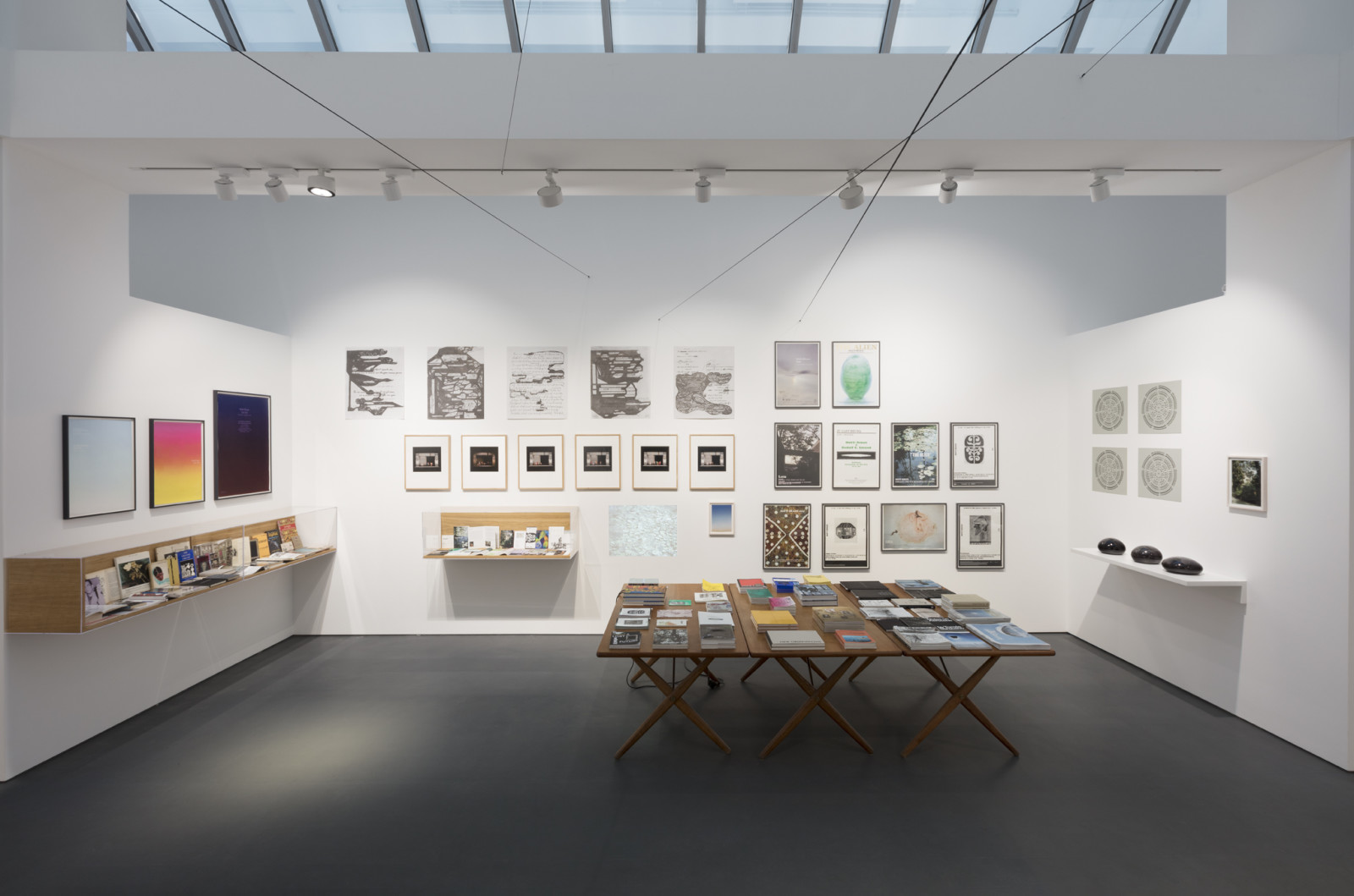 | Matti Braun. Photo © Andrea Rossetti | |
|
In advance of his exhibition in January 2020, Matti Braun's bookstore project in Fall 2019 included prints, editions, rare books, ephemera and publications from his ongoing engagement with the work of Rabindranath Tagore, Vikram Sarabhai, Satyajit Ray, and Indian and Bengali science fiction. Three vitrines were filled with materials from the artist's archive and library, presented in an associative arrangement inviting viewers to discover the connections for themselves.
|
|
|
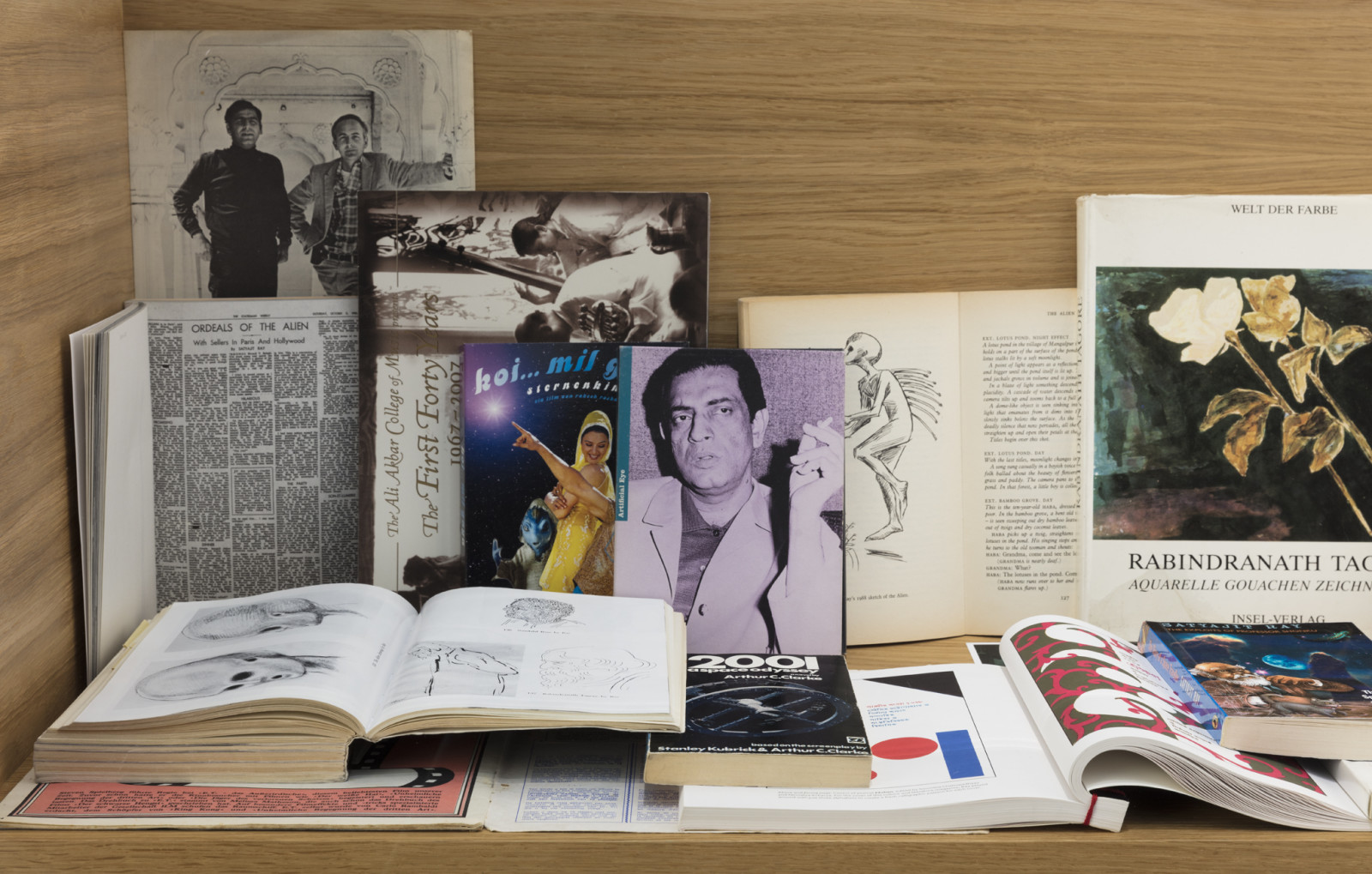 | Vitrine with materials relating to Matti Braun's ongoing research. The photograph in the center shows the director Satyajit Ray who also did the drawings of aliens in the adjacent books. Photo © Andrea Rossetti | |
|
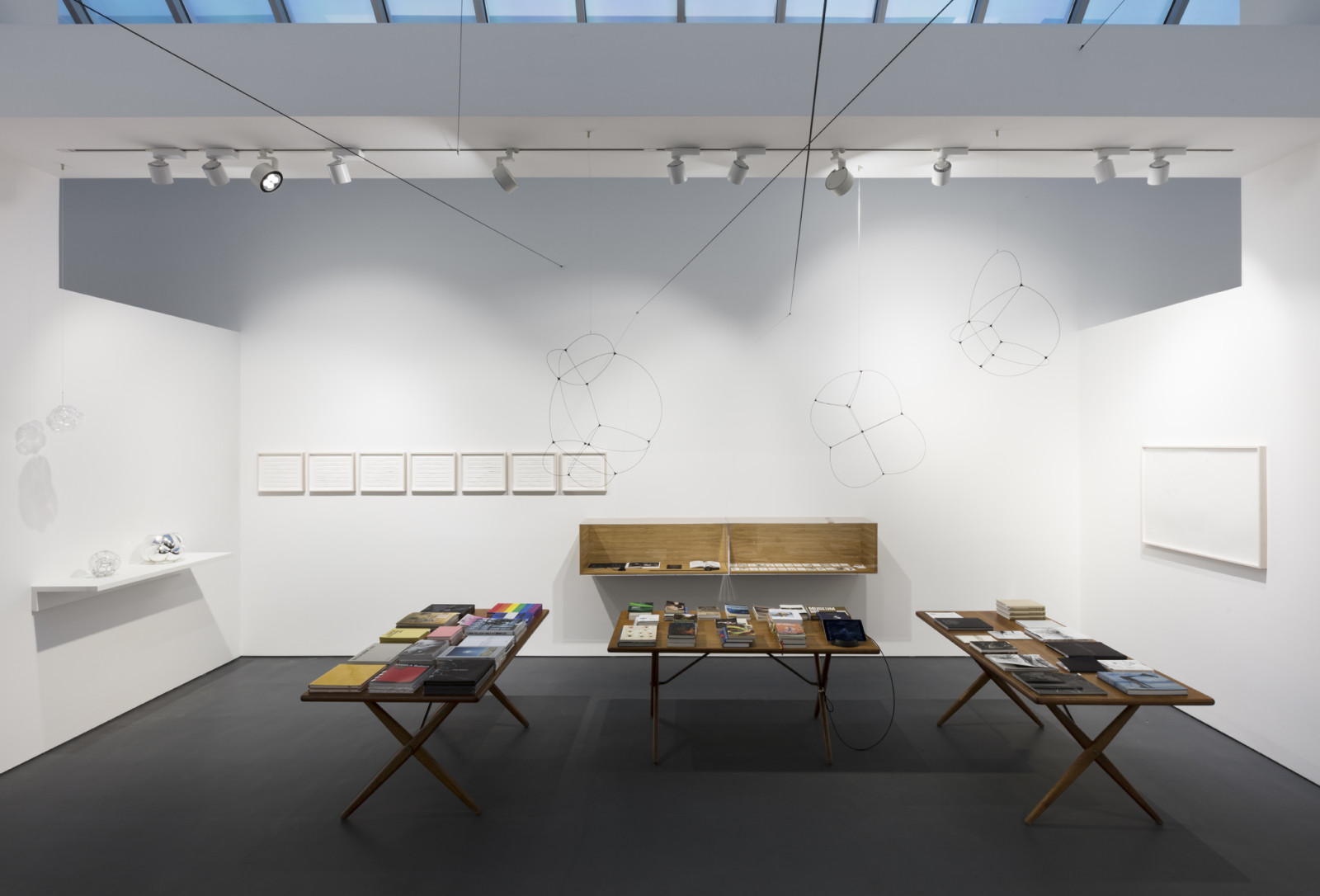 | Tomás Saraceno. Photo © Andrea Rossetti | |
|
Tomás Saraceno presented glass sculptures, editions, works on paper, and a comprehensive overview of his publications. One vitrine was dedicated to his Arachnomancy Cards.
Taking inspiration from various forms of spider divination from different parts of the world, the artist has developed an interactive, site-specific Arachnomancy Cards Deck. They were first created for Tomás Saraceno's project Spider/Web Oracle Pavilion, presented in the 58th Venice Biennale, 2019.
|
|
|
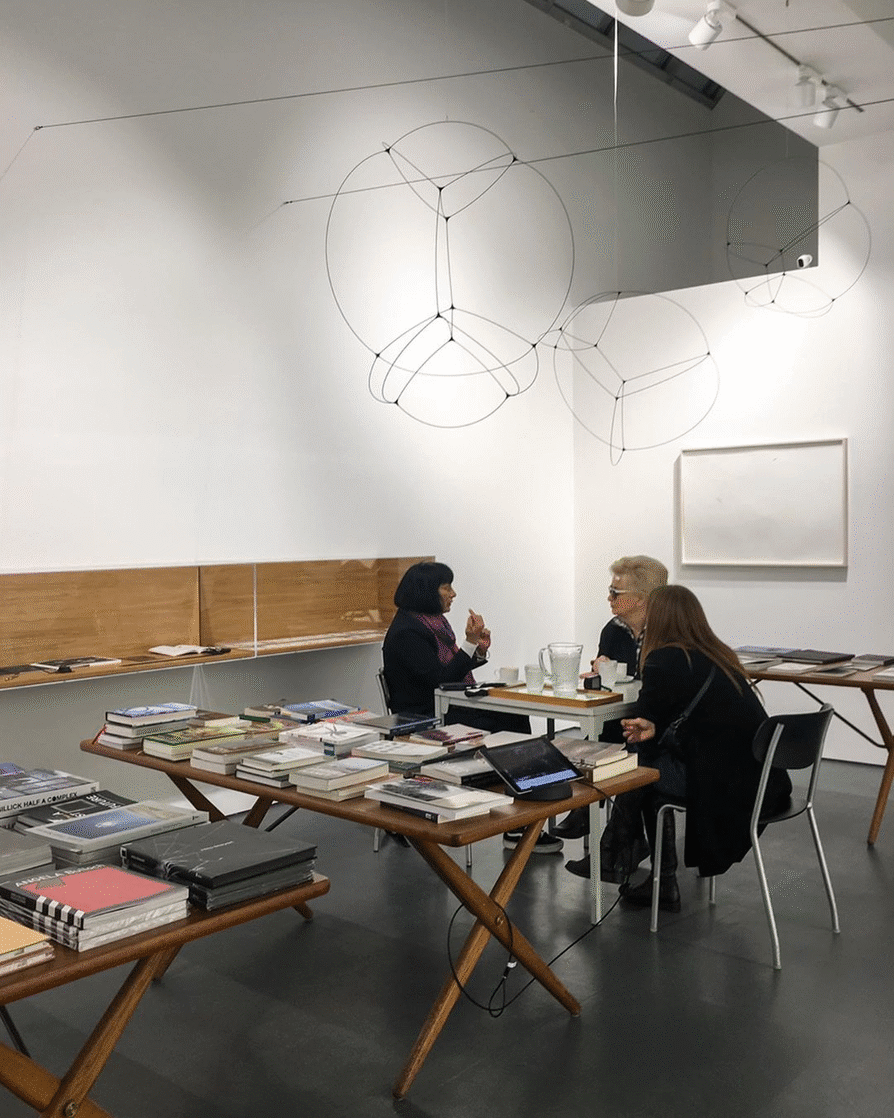 | Impressions from our reading with Tomás Saraceno's Arachnomancy spider divination cards during the presentation of select sculptures, editions, books and ephemera.
| |
|
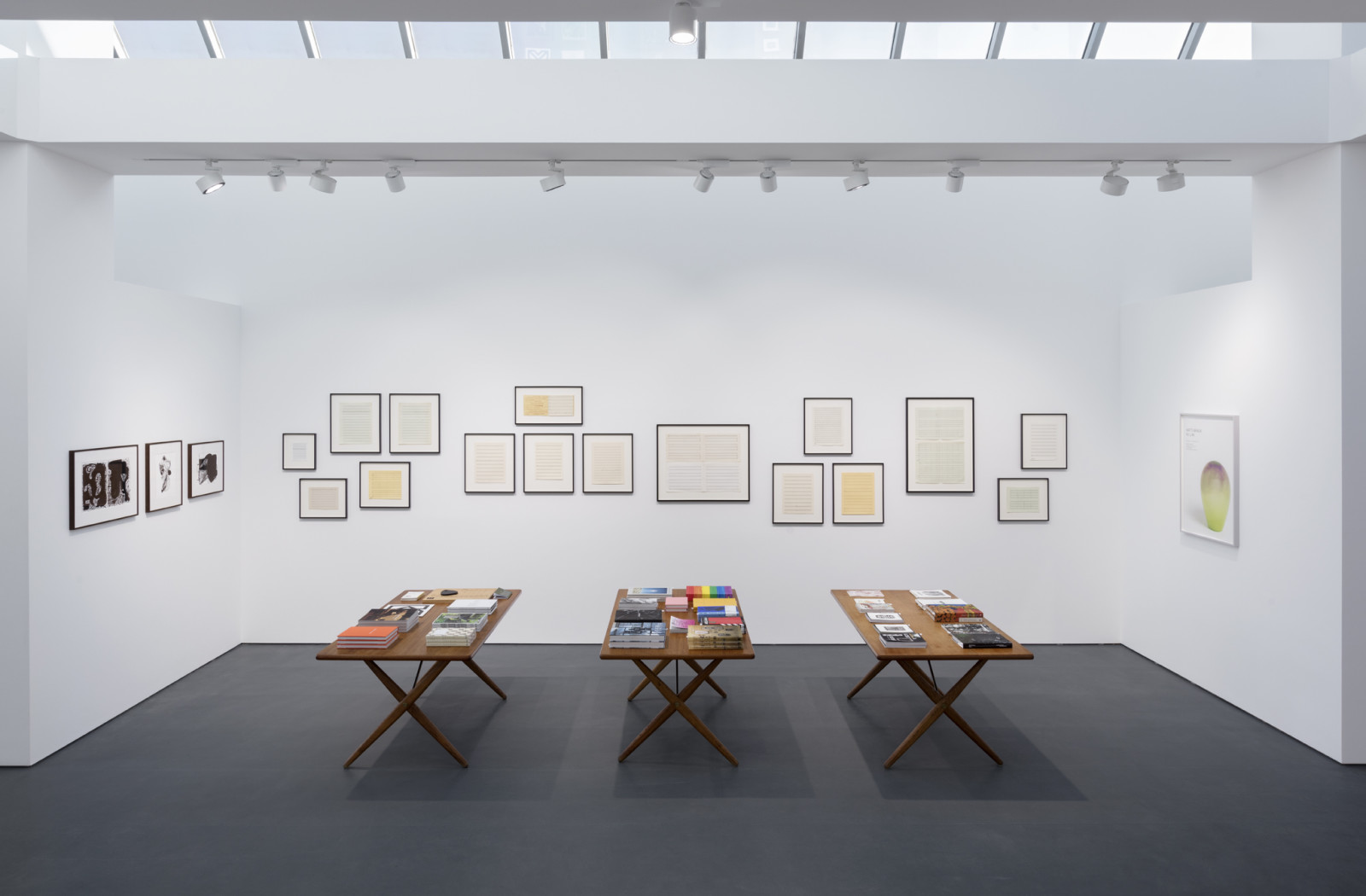 | Works by Ari Benjamin Meyers and Rodney Graham. Photo © Andrea Rossetti | |
|
The selection of works by Ari Benjamin Meyers focused on his series of vintage sheet music incribed with new compositions. Collected from different countries, manufacturers, periods, in various formats and states of use and decay, Benjamin Meyers has inscribed each sheet with a short composition evoked by the very same piece of paper. It takes as point of departure associations the artist has with the paper's origin, format or intended purpose.
The compositions combine the artist's personal associations with a specific piece of sheet music, which in the process become vessels of his thought but also recall traditional practices that because of standardized formats and computerized notations have begun to disappear.
|
|
|
 | Works, editions, and publications by Gabriel Kuri. Photo © Andrea Rossetti | |
|
In February 2020 we opened a presentation of works on paper, collages, editions, and rare artist’s books by Gabriel Kuri which also included collages and works from the artist's series of differently colored pieces of paper with printed letters and numbers, identifying them as coin wrappers from different countries in the Euro-Zone. The order seems to be based on color, not denomination, but remains somewhat mysterious.
The new collage pairs the spiraling circular form of a lock of hair with a loosely corresponding elliptical shape of the fossilized crustacean. The juxtaposition of the fossilized animal with an image of a carefully coiffed mane of hair may evoke the fleetingness of beauty, a suggestion reinforced by the addition of empty coin wrappers as signs of spent currency. The playful yet profound collage is characteristic of Gabriel Kuri‘s work, which continuously explores issues concerning consumerism, the market economy, and the commodification of everyday images.
In a short text below, Gabriel talks about his love of books and of paper!
|
|
|
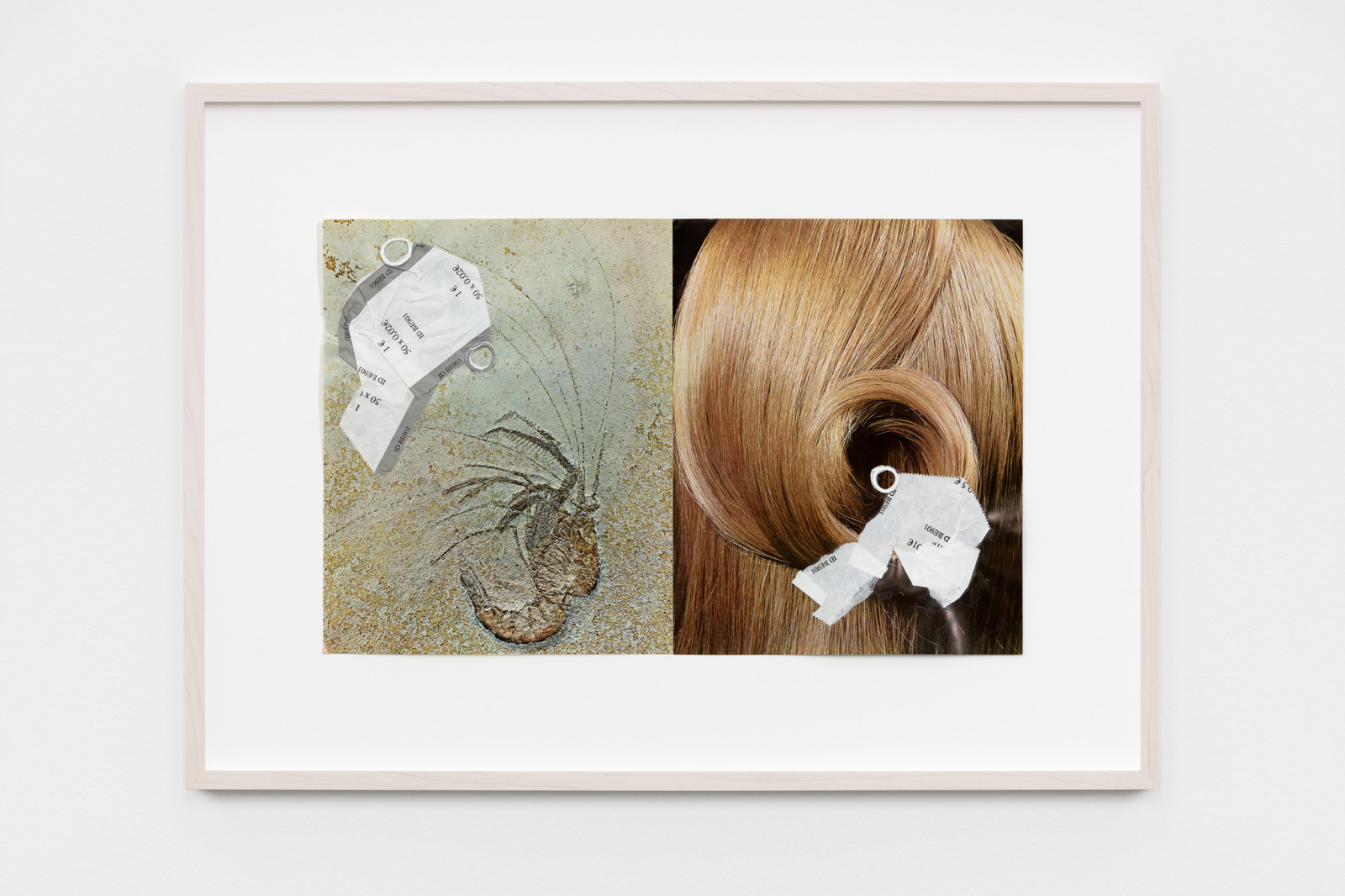 | Gabriel Kuri, Untitled, 2020, collage on vintage magazine pages. 28,4 x 22,7 each, 2 parts (unframed)
46,2 x 63,6 x 3,5 cm (framed). Photo © Andrea Rossetti | |
|
How Do we Read, Together?
|
|
Matti Braun would probably not have made this video without the past weeks of imposed lockdown. It is a hybrid of sorts: a video of someone methodically turning the pages of a book as a voiceover reads out a section. This kind of flipping-through sequence has become a kind of genre on its own. An instrument for online booksellers, especially those of vintage publications that collectors like to peer into before purchasing and for books for which a pdf would appear inadequate. But to me another format came to mind: the flip book.
The flip book it turns out is really old. Patented in 1868 under the name Kineograph its premise is not unlike that of even earlier optical devices such as the 1825 Thaumatrope (“a small circular disc with a drawing on either side and strings attached so that it could be twirled with a spin of the hand”), the Phenakistiscope (“a single disc divided into eight or sixteen segments, each with a slit opening with a figure, representing one position in a sequence” that reflected in a mirror could create the appearance of movement) from the early 1830s, or the Zoetrope (“a turning cylinder around which spectators could view simultaneously simulated action, often sequences of dancers, jugglers, boxers, or acrobats”) popularized in the mid 1830s. Based on contemporaneous scientific discoveries into the physiological conditions of visual perception—especially afterimages and optical illusions created by seeing through the spokes of a moving wheel or by looking at the opposing movements of concentric circles—these instruments became popular modes of mass entertainment in the mid-nineteenth century.
These optical devices are considered proto-cinematic because of the illusion of movement, but their techniques depend foremost on the particularities of the human eye, its fallibility, if you will. It is surprising that human perception is so reliably deceived. Unless you have problems with stereoscopic vision, that is your eyes are not consistently in sync, it’s nearly impossible to resist an optical illusion—it will get you every time. For Jonathan Crary, to whom much of the discussion of these instruments is indebted, this moment signals the relocation of vision in the subjectivity of the observer after two centuries in which it had been considered an objective, disembodied sense: “The body that had been a neutral or invisible term in vision was now the thickness from which knowledge of the observer was obtained.” I particularly love this expression of the thickness—it obliquely refers to the French phenomenologist Maurice Merleau-Ponty’s formulation of “the thickness of flesh between the seer and the thing,“ asserting the presence of the body.
|
|
|
 | Animated Phenakistiscope Disc with Cats and Donkey, ca. 1830. Collection Cooper Hewitt.
| |
|
The connection of the flip book to cinema stands to reason when you consider the cinematic qualities of animation. (It’s no wonder the pioneering director Serge Eisenstein was such a great fan of Walt Disney’s.) It makes perfect sense then that David Claerbout made a flip book for the Städel Museum’s premiere of Die reine Notwendigkeit/The Pure Necessity, his work in reference to Walt Disney’s classic 1967 animated adaptation of Rudyard Kipling's Jungle Book, reconceived to focus on the daily ennui of the animals which are portrayed without any anthropomorphic characteristics. It’s an economical format that can still delight.
Yet most flip books are really about the body, about how our perception can be tricked. Many of them, and there seems to be a thriving contemporary industry, play on this moment of phenomenological wonder: How could this sequence of innocuous looking individual images befool me? Repeatedly. Our surprise at the effectiveness of this phenomenon is compounded by a narrative absurdity and incongruity of elements (say, a yellow rubber duck in a Hokusai print, moving through the waves and ending in the bathtub of a Japanese boy threatened by same wave—yes, it exists). Dissecting the sequence into individual images—the wave, the duck, the boy’s bath—does not inure you to the effects. Once we start flipping the pages, we are at the mercy of our senses.
But the gifs and videos on publisher’s websites work differently yet again. The disembodied slide shows of interior spreads, of cover and back, can give an impression of layout and design, perhaps even a sense of the material, fulfilling a very late modern mix of functions: information, teaser, and entertainment.
Another category within this genre seems to work entirely differently: Hands, not ours, going through a book that we see from the camera’s perspective. It’s a classic cinematic set-up, equating the gaze of the spectator with the camera’s apparatus—yet, there is also an inkling of certain shots in Hitchcock films and B Horror movies: hands tightening around the neck of some wide-eyed ingenue, extending in front of us, from the eye of the camera. It’s a bit creepy (it lost its frightfulness for twenty-first century viewers), but it’s also a very personal act: someone to turn the pages for you.
In an age of machine-reading, these are apparently the experiences we seek out: someone turning the pages of a book for, and, with us. Matti Braun has added an important aspect: the voiceover, returning to the other function of books, reading. His video lets us browse the entire book at a leisurely pace while listening to a section from a text, thus combining this new genre of filmed books with the other wildly popular holdover from the analog era reconceptualized for our moment: the podcast. But those will have to wait for another week.
—Isabelle Moffat
|
|
|
Matti Braun—A Video on a Publication
|
|
A video of the publication edited by Bodhisattva Chattopadhyay, Beth Citron, and Matti Braun with a reading by Joëlle Bargel of an excerpt from the biographical essay "Traveling in a Time Machine to the Golden Age of Science Fiction in Kolkata (1963 - 1985)" by Ranen Ghosh with additions by Santu Bag.
Ranen Ghosh was a Bengali writer, editor and publisher from India. In 1963 he began writing science fiction (or kalpavigyan as the genre is known in Bengali) for the first Bengali science fiction magazine Aschorjo, working with his mentor Adrish Bardhan. After Aschorjo ceased publication, Ghosh edited the short-lived Bismay science fiction magazine with Sujit Dhar and Amitananda Das. After Bismay, Ghosh acted as a co-editor for Adrish Bardhan’s SF magazine Fantastic. Beside kalpavigyan, Ghosh was also an admirer of popular science. He passed away in Kolkata on April 7th, 2019.
The book brings together texts by Parashuram, Beth Citron, Bodhisattva Chattopadhyay, Dip Ghosh, Ranen Ghosh, Soham Guha, Sudhir Kakar, Sami Ahmad Khan, Matthia Löbke, Amrita Shah and presents Matti Braun’s artistic production of the last ten years.
Designed by Yvonne Quirmbach, Berlin. Published by Kunstverein Heilbronn and Snoeck, 2020
|
|
|
Gabriel Kuri—I Love Books
|
|
I love books. By making my own, I learned that they do not have to be second to nor a derivative of my sculptural practice. Whether they are linked to a body or period of work, or exist completely independently, I always make an effort for them to have a life of their own. Books are material memory and register, key concepts in my understanding of what art is and what art can do. Books allow me to see my work as a collection of images. Images as pieces of evidence, metaphors, or signs, or simply—but no less importantly—as an essay of colour. I can see my practice through the narrative resulted from turning pages, which is quite different to pacing around a space.
Books have clear boundaries of size, format, material and binding that I always find helpful rather than limiting. I like to look at my practice through the limited structure of a book format. This shift of mind frame and optics is always helpful and never constraining. After the visible choices of colour, paper and layout in a few of my books, I guess one can see an inclination towards an aesthetics that embraces ordering and didactic principles. Making books is methodical, like my work. The methodology, the technique and of course the teamwork they involve, give me great pleasure, topped by the always welcome sense of surprise of finally holding the embodiment of an idea. I love it that books are mostly consumed intimately. And of course, I love paper.
—Gabriel Kuri
|
|
|

| Gabriel Kuri, Reduce to Improper Fraction, 2018. 32 x 24 cm. Published by Three Star Books, Paris
| |
|
The Reading Corner with Ryan Gander
|
|
In this week’s Reading Corner, Ryan Gander reads I Am for an Art by Claes Oldenburg (1961) to his two daughters, Penny and Olive.
|
|
|
The Reading Corner – A Selection of Publications |
|
Matti Braun
Edited by Matti Braun, Bodhisattva Chattopadhyay and Beth Citron, 2020
Publisher: Snoeck
Language: English
Available here
|
|
|
Daniel Steegmann Mangrané
Ne voulais prendre ni forme, ni chair, ni matière
Publisher: Bom Dia Boa Tarde Boa Noite, 2020
Language: French
Available here
|
|
|
General Idea
P is for Poodle
Publisher: Mitchell-Innes & Nash, 2020
Language: English
Available here
|
|
|
Anri Sala
As You Go
Publisher: Skira, 2020
Language: English, Italian
Available here
|
|
|
Gabriel Kuri
sorted, resorted
Publisher: WIELS, Brussels and Koenig Books, London, 2019
Language: Dutch, English, French
Available here
|
|
|
A paintbrush, a camera, a robot, disregarded doorstops or even an Ouija board – how much can you tell of an artist by what’s in their studio? SEE INSIDE THE STUDIO HERE
|
|
|
Journey Through the Gallery
|
|
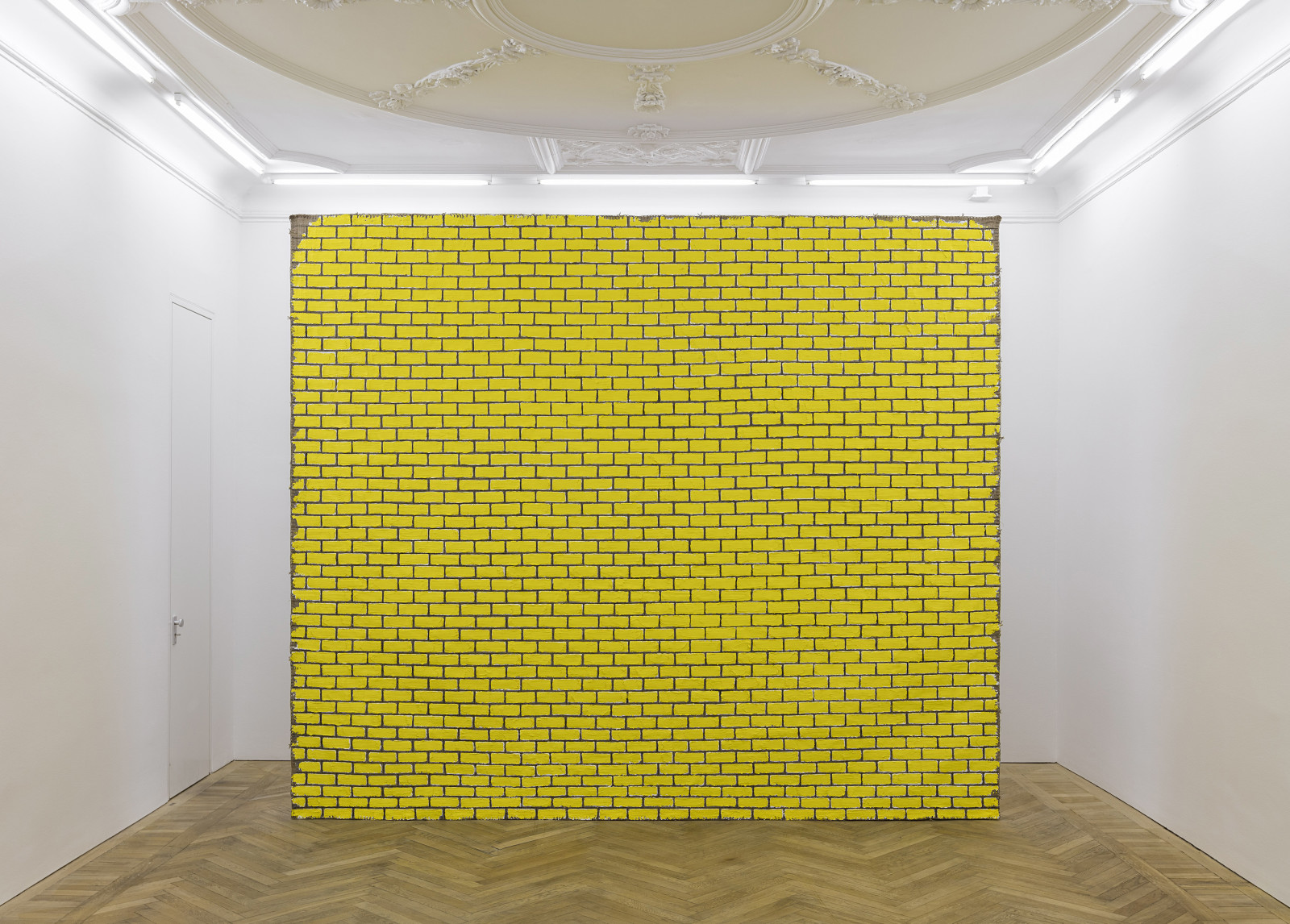
| Ugo Rondinone, erstermärzzweitausendundsechzehn, 2016, oil on burlap, 340 x 400 cm
Exhibition view: Ugo Rondinone, two men contemplating the moon 1830, Esther Schipper, Berlin, 2016
Photo © Andrea Rossetti | |
|
In 2016, Esther Schipper presented two men contemplating the moon 1830, Ugo Rondinone’s fifth solo exhibition with the gallery.
Taken from a painting by Caspar David Friedrich, the exhibition’s title makes manifest Rondinone’s long-standing indebtedness both to the iconography and philosophy of German Romanticism. “The German Romantic movement was the first to blur the line between reality and illusion. In this sense I’m very attached to the idea of art and art making as an environment that is itself outside of time and inaccessible to a linear logic.“ (The Brooklyn Rail, 2013).
Rondinone modified the exhibition space to create a self-contained environment: new walls cover the existing windows. The works themselves index architectural barriers between outside and inside—a monumental new series of aluminum-cast windows, a large-scale brick-wall painting and a new series of concrete sculptures cast from the corners of urban buildings—collectively comprising the space of an inner world.
Rondinone’s windows—a recurring motif in his work since the 1990s—play on the combination of the familiar and the strange. Rather than framing a view to the outside, they themselves become objects to be looked at. In the current exhibition, these new aluminum-cast windows are each titled after a specific Friedrich painting, and when the series is completed, will stand in for Friedrich’s complete oeuvre, 160 windows in total.
A large-scale oil painting with a brightly colored yellow brick pattern creates the impression a new wall has been installed in the exhibition space. Creamy brushstrokes and heavy impasto form bricks; the brown color of the raw burlap doubles as ground and grout. Installed at one end of the room on a wooden frame about one meter from the existing wall, the painting’s exposed back shows the seams of roughly stitched-together patches of the raw material.
|
|
|
Under the heading Messages from Home artists are sharing videos from their (temporary) studios or homes.
Here, Tao Hui shares snapshots of his life from his hometown, Yunyang, Chongqing, as well as his journey back to Beijing. ⠀ |
|
|
|
|